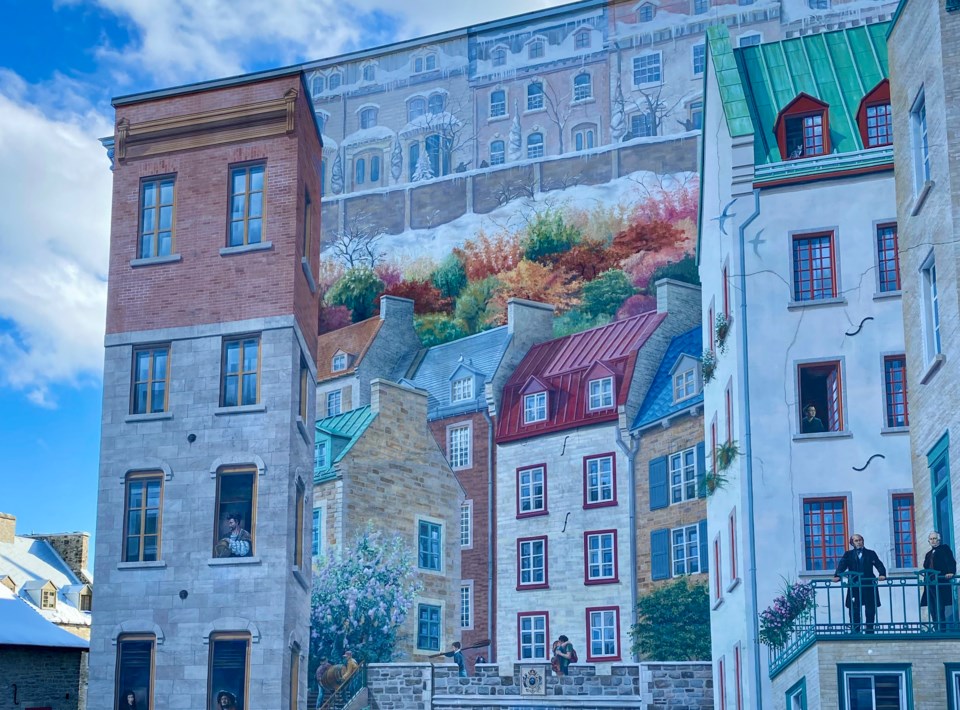In my last column (Pique, Feb. 24), we’d started a winter trip to Québec by making our way through the Lanaudière and Mauricie regions northeast of Montreal. Winter fun was on tap everywhere we went, but we knew the beating heart of the province’s invernal culture lay further east, in the provincial capital of Québec City, our next stop.
To that point, maple-syrup-infused food and drink had been ubiquitous, but to really tap (ha ha) into this element of Québec gastronomy we’d have to step it up. That started with brunch at the Sugar Shack-themed La Bûche (the log), with a maple-syrup-addled meal of beans, crêpes, sausage and the most delicious bacon I’ve ever eaten (trust me—I keep track). Not only that, but the appetizer was a heavenly poutine—Belgian-style fries, squeaky (ergo fresh) cheese curds, and gravy with a hint of maple.
To work off that caloric mess, some of us chose a walking tour (you can also do it on fat-bikes) of the Old City founded by Samuel de Champlain in 1608, with its historic buildings, defensive ramparts and outdoor art that has garnered UNESCO World Heritage status. The more adventurous among us opted for ice canoeing.
Practiced nowhere else on Earth, the pure, beautiful madness of crewing a specially designed canoe across the frigid St. Lawrence River through moving ice floes is not for the faint of heart or risk-averse (see my 2015 report).
Ice canoeing remains a quintessential Quebecois sport evolved from a utilitarian need to connect the north and south shores of the river in winter before there were bridges. Although thousands watch ice-canoe races from shore with a cup of boozy hot chocolate and six layers of clothing, they still get chilled, while competitors in this highly aerobic insanity wear much less since they cannot, under any circumstances, stop moving. Apart from a huge set of gonads, key equipment includes a flotation vest, shin-pads and either boots with bolts screwed to the bottom or crampons pulled over neoprene booties. Ice canoeing may not be on everyone’s bucket list, but it’s one of the raddest, not-to-be missed experiences ever.
To soothe the adrenalin of the day, we enjoyed Indigenous storytelling in the authentic longhouse at Wendake that evening, followed by dinner there rendered by a Michelin-starred chef—whitefish caviar on bannock fingers, anyone?
As befits a 420-year-old city, historic stays abound in Q.C.—like Hôtel Clarendon, built in 1878 overlooking the old city, from whose oval windows I watched roped-up workers clear snow from a nearby church roof. More history dwells on the Plains of Abraham, a former battleground for colonial European forces but these days the site of tobogganing, cross-country skiing and the myriad activities of the Carnaval de Québec—a pre-Lenten celebration third in size globally behind only the fêtes of Rio de Janeiro and New Orleans. Bonhomme (“happy man”), Carnaval’s Michelin-Man-meets-Mr.-Stay-Puft ambassador, is everywhere, and if he takes you by surprise in a restaurant (he did us), protocol dictates you go in for a hug.
Beyond the city we found alpine skiing at Stoneham and Mont Ste. Anne, plus ski, snowshoe and fat-bike trails at Parc national de la Jacques-Cartier—a stunning glacial valley surrounded by plateaus.
On the way back to Q.C., we added a tour of Hôtel de Glace. Since opening in 2001, Québec’s world-famous ice hotel has morphed from a gimmicky sleepover amidst stacks of ice blocks to a technological marvel and work of art. It takes an army of people more than a month to build its cavernous gathering areas, crystalline sculptures, indoor bar, and dozens of rooms themed with incredible carvings and dazzling décor.
Fittingly, we finished a long day in nature with dinner at Restaurant Légende, featuring a fully boreal cuisine—including the wine pairings—in which each plate is a sensory journey through Québec terroir, whether field, forest, river or ocean. The multi-course chef’s dinner was spectacular, with treats like cod in sturgeon broth, wagyu beef fat and fermented oyster mushrooms (if I’d read that on a menu on my own I probably wouldn’t order it, but it blew my mind).
To finish the trip, we drove 3.5 hours east up the Fleuve Saint-Laurent to Saguenay-Lac-Saint-Jean region, landing at Mont Édouard, a ski hill of a respectable 450 vertical metres with backcountry hut-to-hut touring and gladed descents; the “Haute Route Sector” includes eight summits and four cabins spread over 81 hectares. Touring to the first reachable cabin—about an hour of skinning—was a perfect introduction. As we navigated the final summit ridgeline of stunted trees, the heavy ceiling lifted just enough to spot cabins atop nearby mountains, and the powder stashes draping the latter’s flanks.
During dinner at venerable Auberge des 21, we learned about the largest ice-fishing villages on Earth situated on Saguenay Fjord, and the traditions and regulations of ice-fishing in the area—not to mention the 20-some species you can catch. We overnighted at Imago Village—a unique cluster of personally appointed glamping domes started by a company that not only makes yurts, but serves up a filet-mignon-adorned poutine with a spicy gravy.
Our final outdoor excursion in Saguenay was a snowshoe climb to the Vallée des Fantômes (Valley of the Ghosts—snow ghosts to be specific) in Parc National des Monts-Valin. Actual ghosts were few and far between in a somewhat low-snow winter, but from the summit you could see all the way to cliff-lined Saguenay Fjord, a summertime stop for whalewatchers. Clearly, we’d have to come back to découvrir more.
Leslie Anthony is a Whistler-based author, editor, biologist and bon vivant who has never met a mountain he didn’t like.




